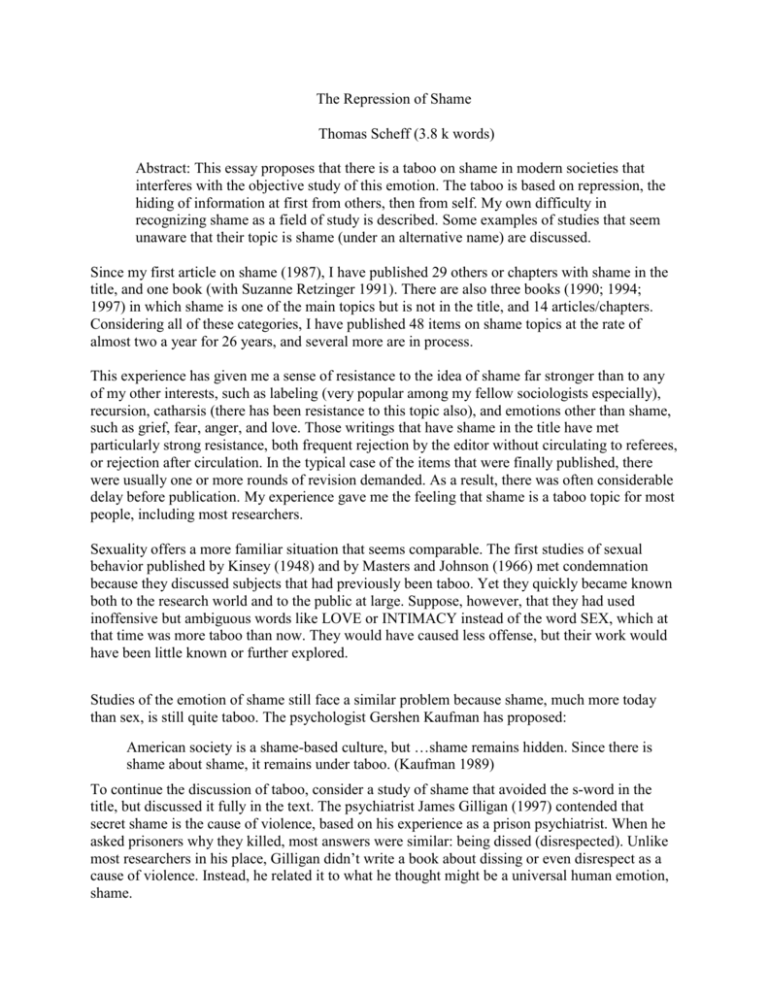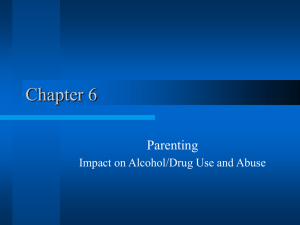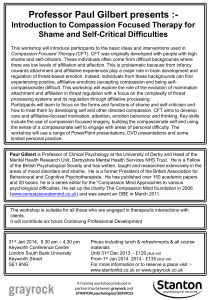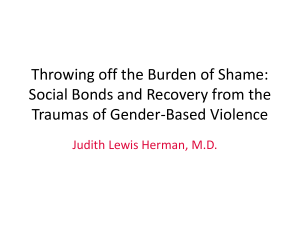Thomas Sheff, Shame - Norbert Elias Foundation
advertisement

The Repression of Shame Thomas Scheff (3.8 k words) Abstract: This essay proposes that there is a taboo on shame in modern societies that interferes with the objective study of this emotion. The taboo is based on repression, the hiding of information at first from others, then from self. My own difficulty in recognizing shame as a field of study is described. Some examples of studies that seem unaware that their topic is shame (under an alternative name) are discussed. Since my first article on shame (1987), I have published 29 others or chapters with shame in the title, and one book (with Suzanne Retzinger 1991). There are also three books (1990; 1994; 1997) in which shame is one of the main topics but is not in the title, and 14 articles/chapters. Considering all of these categories, I have published 48 items on shame topics at the rate of almost two a year for 26 years, and several more are in process. This experience has given me a sense of resistance to the idea of shame far stronger than to any of my other interests, such as labeling (very popular among my fellow sociologists especially), recursion, catharsis (there has been resistance to this topic also), and emotions other than shame, such as grief, fear, anger, and love. Those writings that have shame in the title have met particularly strong resistance, both frequent rejection by the editor without circulating to referees, or rejection after circulation. In the typical case of the items that were finally published, there were usually one or more rounds of revision demanded. As a result, there was often considerable delay before publication. My experience gave me the feeling that shame is a taboo topic for most people, including most researchers. Sexuality offers a more familiar situation that seems comparable. The first studies of sexual behavior published by Kinsey (1948) and by Masters and Johnson (1966) met condemnation because they discussed subjects that had previously been taboo. Yet they quickly became known both to the research world and to the public at large. Suppose, however, that they had used inoffensive but ambiguous words like LOVE or INTIMACY instead of the word SEX, which at that time was more taboo than now. They would have caused less offense, but their work would have been little known or further explored. Studies of the emotion of shame still face a similar problem because shame, much more today than sex, is still quite taboo. The psychologist Gershen Kaufman has proposed: American society is a shame-based culture, but …shame remains hidden. Since there is shame about shame, it remains under taboo. (Kaufman 1989) To continue the discussion of taboo, consider a study of shame that avoided the s-word in the title, but discussed it fully in the text. The psychiatrist James Gilligan (1997) contended that secret shame is the cause of violence, based on his experience as a prison psychiatrist. When he asked prisoners why they killed, most answers were similar: being dissed (disrespected). Unlike most researchers in his place, Gilligan didn’t write a book about dissing or even disrespect as a cause of violence. Instead, he related it to what he thought might be a universal human emotion, shame. Although there is some personal and cultural variation in the triggers and manifestations of shame, it also seems to be universal as a mammalian signal of threat to the social bond, the emotion, however slight or intense, associated with the possibility of rejection. Since everyone from birth is vitally concerned with being accepted as a fellow member of the tribe, shame is crucial to the human condition. Although there are always personal and cultural triggers for shame, it also seems to be universal as a mammalian signal of threat to the social bond, the feeling, however slight or intense, of rejection. The difficulty in studying shame in modern societies is that like the f-word, the s-word is still taboo. For that reason, there are many studies of the shame system, but hidden under other terms: fear of rejection, disrespect, stigma, honor cultures, revenge, etc. Gilligan’s book was not a huge success, either commercially or academically. It was never on the bestseller lists; it stands currently around the 30 thousandth mark. According to Google Scholar, it has been cited 400 times, which is 24 times a year since its publication. It seems that it has been little noticed by the public or by scholars. If the word shame had appeared in the title, it might have fared much worse. With a different title and approach, it might have been a best seller. The actual title, Violence: reflections on a national epidemic, is not exciting nor does it adequately reveal the content. The publisher may have not allowed the use of shame in the title, as sometimes happens1. Perhaps Dissing and Violence would have had more appeal. But if Gilligan had wanted the word dissing in the title, he might have had to settle for the dissing-disrespect thesis, not even mentioning his notion of secret shame. The s-word would not be appealing; it could be even repulsive. What could be repulsive about the s-word, since it’s only a word? One could ask the same question about the f-word, since it also is only a word. It is clear that the f-word was completely repulsive for the sixty years before 1961, at least in print. According to the Google Ngram, there was not a single occurrence in books in the English language between 1900 and 1960. It appears that printed books were fussy about this matter, since when I was in basic training in the Army in 1953, it seemed to be almost every other word out of the mouths of trainers and trainees alike. Oddly, with the f-word getting more exposure beginning in 1961, the s-word has been getting less. The N-gram shows that the frequency of use in English language books has been decreasing steadily for two hundred years (1800-2000). This fact is particularly striking knowing that there are some usages that are not taboo such as “What a shame!” and the jokey “Shame on you!” That these two phrases are inoffensive to anyone suggests that the s-word is still less taboo than the f-word. Although there are comparable uses of the f-word that don’t refer to sex, (like “What the fuck?”), they are still offensive to some people. To see if the decline in the usage of the s-word in print was in English only, I checked the Ngrams for French (honte), German (schande) and Spanish (verguenza) equivalents. The I know that this was the case with Smith’s (2006) book, which was entirely about the humiliation of the Third World by the First World. I learned about this book only by chance. 1 decrease has been occurring in these languages also over the two hundred years. What is going on? The Taboo on Shame From his study of five hundred years of European history, the sociologist Norbert Elias (1939; 1978) proposed that shame and its close kin (embarrassment and humiliation) have become the dominant emotions in modern societies, even though they are taboo. As already indicated, these three emotions have also been frequently studied in social/behavioral, political and medical science (particularly psychiatry), and history, but under different names. There are many studies in anthropology of “cultures of honor”: how insults to honor lead to humiliation and revenge. Most of these studies however, assume that this cause of violence is valid only in traditional societies, where shame is less hidden. It is not considered to occur in modern societies. Although the word honor has gone out of style, the emotion of shame has not. If it is biologically based, it would be ahistorical and cross cultural universal. The taboo on shame has many weakening effects on knowledge, because it cordons off into separate groups what ought to be a single field, reinforcing the existing taboo. For example, it hides other studies that support’s Gilligan’s conjecture on hidden shame as a cause of violence, such as status attainment, loss of social status, search for recognition, honor/dishonor, vengeance or revenge, and so on. It also slows down the process of replicating studies that support it (Lacey 2009; Websdale 2010), and testing a broader hypothesis extending to the way in which shame and anger causes violence, and shame alone, silence (Scheff 2011). If the shameviolence/silence hypothesis is even partly true, it carries a crucial message for our civilization. Elias’s thesis is that there is a difference between shame that is felt, the basis of morality, and shame that is hidden not only from others but even from self. In his study (1939; 1978), he analyzed etiquette manuals in three languages. Two key findings: 1. As physical punishment decreased, shame became dominant as the main agent of morality. 2. As shame became more prevalent, it also went underground, becoming virtually invisible. Emotions in Psychotherapy A study of emotion in psychotherapy seems to uphold Elias’s theses. Helen B. Lewis (1971), a research psychologist as well as a psychoanalyst, used a systematic method (Gottschalk and Glaser 1969) to locate verbal emotion indicators in many transcriptions of psychotherapy sessions. She seems to have been unaware of Elias’s study. She found, to her surprise, that shame/embarrassment was by far the most frequent emotion, occurring more than all the other emotions combined. She also found that these instances of shame/embarrassment, unlike joy, grief, fear, or anger, were virtually never mentioned by either the client or the therapist. She called the unmentioned instances "unacknowledged shame." Her findings provide support, at the word by word level, for Elias’s thesis of the prevalence and invisibility of shame at the historical level. She also found that the shame in these episodes seemed to be hidden in two different ways. Overt, undifferentiated shame (OUS) involved painful feelings that were hidden behind terms that avoided the s-word (Elias used the word “circumlocutions). Bypassed shame, on the other hand, involved rapid thought, speech, or behavior, but little feeling. OUS is marked by pain, confusion, and bodily reactions such as blushing, sweating, and/or rapid heartbeat. One may be at a loss for words, with fluster or disorganization of thought or behavior, as in states of embarrassment. Many of the common terms for painful feelings appear to refer to overt, undifferentiated shame: feeling peculiar, shy, bashful, awkward, funny, bothered, or miserable; in adolescent vernacular, being freaked, bummed, or weirded out. The phrases “I felt like a fool,” or “a perfect idiot” are prototypic. Some of the substitute terms are complex, such as, “an awkward moment:” It’s not me that embarrassed (denial), but the moment that is awkward (projection). One article (Retzinger 1995) lists over a hundred substitute words and phrases. Bypassed shame is manifested as a brief painful feeling, usually fleeting, followed by obsessive and rapid thought, speech or activity to displace the feeling. A common example: one feels insulted or criticized. At that moment (or later in recalling it), one might experience a very brief jab of painful feeling, followed immediately by imaginary replays of the offending scene. The replays are variations on a theme: how one might have behaved differently, avoiding the incident, or responding with better effect. One is obsessed. It seems to me that Lewis’s use of a systematic method to detect emotion terms might have led to underreporting of bypassed shame. The method she used would locate OUS terms, usually missing the obsessive talk and/or thinking that characterize bypassed shame. Billig’s Explicit Theory of Repression Elias’s second thesis (As shame became more prevalent, it also went underground, becoming virtually invisible) raises the question of repression, a difficult topic. The nature of repression was more or less a mystery to its discoverer, Freud, but has been explored in detail by the English psychologist, Michael Billig (1999). Freud stated in his history of the psychoanalytic movement that "the theory of repression is corner-stone on which the whole structure of psychoanalysis rests." Yet Freud admitted that he knew very little about it. In The Introductory Lectures, published when he was over sixty, the confident head of the psychoanalytic movement, Freud stated: "…so far we have only one piece of information [about repression]…that [it] "emanates from forces of the ego." Apart from that, Freud added, "we know nothing more at present." This comment doesn’t tell us much, since we have no way of knowing what forces Freud was referring to, nor for that matter, how the ego itself is to be understood. Based on his examination, word by word, of Freud’s writings, not only his cases but his letters, Billig proposed that repression arises from social practices regarding topics or feelings that are generally regarded in a particular society as too shameful to discuss. At the time that Freud's lived in Vienna, sexuality, for example, was such a topic. Billig proposed that repression begins in social practices of avoidance. For example, one of Freud’s cases, “Little Hans” learns from dialogue with his mother and father that certain topics (sexuality, anger, aggression, etc.) are not to be discussed. If one of these topics is raised, the parent routinely changes the subject to another topic, one that is not forbidden. This transition may be marked by small, innocuous phrases, such as "Even so," "Oh, well," and so on. Billig’s theory of repression suggests that it begins with social practices of avoiding certain topics. How are these practices internalized by individuals? Billig's theory is not completely articulated. But it suggests two steps. First, learning the social practice of routinely avoiding a certain topic by changing the subject to another topic. This practice is intentional at first; it results in a collective failure to notice the forbidden topic. Perhaps after many repetitions, the individual takes the second step, learning to routinely avoid noticing his or her practice of avoiding the forbidden topic, as well as by changing the subject to one that is not forbidden. This second step functions to remove the forbidden topic from conscious awareness. If this second step fails to remove the shame, a third and even subsequent steps can be taken. The idea that once can avoid remembering one’s avoidance is suggestive of a recursive process that can go on indefinitely. This process is noticeable, particularly, in one of Freud’s case discussed by Billig: “The Rat Man.” Personal Experiences Given my difficulties with publishing shame topics, I begin to a feel a little like Freud’s patient, “Little Hans,” mentioned above. The editors and publishers seemed to me to be attempting to change the subject in order to avoid a taboo topic, using a wide variety of justifications. One favorite was protocol: this paper is too short or long, too psychological or not psychological enough, doesn’t provide enough evidence to support the theory, and so on. These experiences led me to ask a personal question: why I am willing to write about shame when most people avoid it? It seems to me now that it took two steps that allowed my interest to arise. The first step occurred in 1970: in group psychotherapy I discovered to my surprise that I was awash with emotions that I hadn’t felt, especially grief, fear, anger, and shame. After about a month of extremely intense crying, laughing, sweating/shaking, and body heat (instead of venting anger), I felt immensely better, and especially better about myself. Because of these events, I continued in various forms of psychotherapy for some 31 years. However, a second step seemed to have been necessary before I became willing to commit myself to the study of shame. After my 1970 experience with emotions, I thought I might try to deal not only with my own but also see if I could help other people with theirs. An opportunity occurred when a psychiatrist I was seeing decided that he wanted me to become a therapist myself. The state of California at that time was introducing a new therapist license: Marriage and Family Therapist (MFT). My psychiatrist, with great disregard for the incompleteness of my training, was able to grandfather me in to a license. Since I was a full time academic at the time (UCSB; Sociology), I didn’t see how could practice even though I had an MFT. However, a further opportunity allowed me to practice under a very capable supervisor. By chance, along with two other newly licensed therapists, an experienced social worker, Marilyn Nadler, recruited me to help her with what she called “Intensives,” forty hours of individual and group psychotherapy for a client in a single week. This practice, which went on for almost two years, was enormously successful. Like the other two amateur therapists, I assumed that I had somehow become a skillful therapist. However, when Marilyn moved away, our bubble burst. After utter failure with a client, I realized that our success had been entirely due to Marilyn’s skill: we were useless without her. It was at this point that I decided that if I couldn’t be an emotion therapist, I would become an emotion researcher. However, during my two years of being a therapist, I learned something that seemed important: venting anger doesn’t usually help. I was trained to encourage clients to vent in order to get the anger “off their chest.” But my clinical experience strongly suggested that venting was almost always a mistake. Clients complained that they felt no better, or even that felt worse after venting. Neither my trainers nor I knew that Berkowitz’s study (1962) had raised doubts, nor of course, of the steady stream of supporting studies that were published after my time as therapist (1966-68). My question became: if venting doesn’t help anger, what does? I found what looked like a step toward an answer in a book by Helen Block Lewis (1971). Although I had difficulty in understanding much of the writing because it was laden with psychoanalytic jargon, she showed many instances of unacknowledged shame sequencing into anger (Chapter 6, for one). Perhaps my problem with angry clients may have been because I didn’t look for the shame underneath. I read everything I could find about shame. With my wife, Suzanne Retzinger, we also made contact with Helen Lewis. Since we formed the habit of visiting her at Yale University where she worked, she took us on in a mentor-student relationship for many years. Hidden Studies of Shame There are many fields of study of shame that use alternative terms in a way that cuts off the relationship to other shame studies. For brevity, out of the many instances, I will describe only two: the field of facial expression of emotion, and the study of stigma. Facial Expression of Emotion Studies of the facial expression of emotion, a huge field, were based on the foundational descriptions of basic emotions by Silvan Tomkins. But for many years until quite recently, these studies did not include shame, even though Tomkins gave more attention to it than any other emotion, taking up almost all of one of four volumes (V. II, 1963). Another example is stigma. There are thousands of studies in the social, behavioral and medical sciences of this topic. The idea is that police arrest or illness diagnosis may carry with it an unintended consequence: the shaming of the recipient, to self and/or his/her social network. These studies virtually never use the term shame in the title, and in most cases, even in the body of the study. Nor do they cite the shame literature. This case illustrates the taboo the most strongly, since shame is the literal dictionary meaning of stigma. Goffman’s Stigma (1968) clearly equated stigma with shame (pp. 13, 14, 25, 108). But by 1980, when articles on stigma started appearing, the term shame had disappeared. This absence is particularly noticeable in an attempt to conceptualize stigma (Link and Phelan 2001). Although they quote Goffman’s book at some length, there is no mention that he equated stigma with shame. Another example is an edited reader on the social psychology of stigma. Neither shame, embarrassment nor humiliation is in the index or in any of the chapters that I read. Several mention Cooley’s idea of the looking glass self, but without noting that this idea involves shame: “[The looking glass self] seems to have three principal elements: the imagination of our appearance to the other person; the imagination of his judgment of that appearance, and some sort of self-feeling, such as pride or mortification [shame] (p. 184, 1922). Conclusion The idea that shame is taboo in modern societies, to the extent that it proves to be true, suggests the need for more discussion and studies in this area. If shame is indeed a key to understanding human relationships, we would need to bring out in the open. References Berkowitz, Leonard, 1962. Aggression: A Social Psychological Analysis. New York: McGrawHill. Elias, Norbert. 1939. Über den Prozess der Zivilisation). Reprinted in 1978 as The Civilizing Process. London: Blackwell. Billig, Michael 1999. Freudian Repression: Conversation Creating the Unconscious. Cambridge University Press. Cooley, Charles H. 1922. Human Nature and the Social Order. New York: Scribner’s Gilligan, James. 1997. Violence – reflections on a national epidemic. New York: Vintage Book Gottschalk, Louis, Winget, C. and G. Gleser. 1969. Manual of Instruction for Using the Gottschalk-Gleser Content Analysis Scales. Berkeley: UC Press. Hetherton, Ted, Kleck, R., Hebl, M., and Jull, J. The Social Psychology of Stigma. New York: Guilford. Kaufman, Gershon. 1989. The Psychology of Shame. New York: Springer. Kinsey, Alfred, W. Pomeroy, and C. Martin. Sexual Behavior in the Human Male. Indiana University Press, 1948. Lewis, Helen B. 1971. Shame and Guilt in Neurosis. New York: International Universities Pre Link, Bruce and Jo Phelan. 2001. Conceptualizing Stigma. Annual Review of Sociology 27, 363385. Masters, W.H.; Johnson, V.E. (1966). Human Sexual Response. New York: Bantam Books. Retzinger, Suzanne. 1995. Identifying Shame and Anger in Discourse. American Behavioral Science. 38: 104-113 Scheff, Thomas. 1987. Interminable Quarrels: A Case Study of a Shame/Rage Spiral. In The Role of Shame in Symptom Formation. (Helen B. Lewis, ed.), LEA: Patterson, NJ _______________1990. Microsociology: Emotion, Discourse, and Social Structure. Chicago: Univ. of Chicago Press _______________1994. Bloody Revenge: Emotion, Nationalism and War. Boulder, Colo. Westview Press _________________1997. Emotions, the Social Bond, and Human Reality: Part/Whole Analysis. Cambridge: Cambridge University Press Scheff, Thomas, and Suzanne Retzinger. 1991. Emotion and Violence: Shame and Rage in Destructive Conflicts. Lexington, MA: Lexington Books Smith, Dennis. 2006. Globalization: the Hidden Agenda. Cambridge: Polity Tomkins, Silvan. 1963. Affect, Imagery, Consciousness: The Negative Emotions, V. II. London: Tavistock 87-3752-12/2/13







